Telegrams: stages involved from sending to delivery in the past
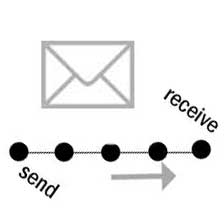
This page describes the stages involved between sending and delivering telegrams in the past. The author is an authority on this as his first job in 1972 was as a Post Office telegraphist based at the Central Telegraph Office (CTO) just off Fleet Street in central London. The work involved accepting telegram messages over the phone and then forwarding them by teleprinter for delivery. Although when he joined the service, it was already in decline, he learnt a lot about how it had previously worked because some of the equipment was quite old.
____
By David Pickles, a former telephone engineer
How the public sent and paid for a telegram
Sending a telegram was different depending on whether the person sending it had ready access to a phone. If not - as was usual with ordinary people before the 1950s - they would go to the local post office and send it from there. With access to a reliable phone, they would dial 190 for the Central Post Office (CTO), which was free. Then they would speak their message to one of the telegraphists and give details of where it should be delivered and what type of telegram they wanted.
Types of telegram
Before the 1950s there only two types of telegram: standard and greeting. The greetings one cost more because it would be printed on fancy paper at the receiving post office. There were several styles of fancy paper, but the sender had no control over which one would eventually be used as that depended on what was in stock at the receiving post office. Some examples of the styles of telegram paper are shown on the page about the importance of telegrams in the past.
By the end of the service in September 1982 there were the following types of telegram:
- an ordinary telegram
- an 'overnight' telegram which was half the price and was delivered the next morning
- a priority telegram for around 25p extra which would usually be delivered within the hour
- a wedding telegram on suitably attractive paper which we called a WG1
- a birthday telegram, also on suitably attractive paper which we called a BH2
- a new born baby telegram, also on suitably attractive paper which we called a BB5, and
- an all-purpose greeting telegram which we called an AP8.
Payment
The telephonist would tell the caller the total cost once the caller had dictated the telegram and confirmed the number of words and the type of telegram wanted.
The charges of telegrams sent from private phones were added to the next phone bill. For calls sent from telephone boxes, callers would insert their money into the coin slots. Telegraphists knew how much was going in as they heard different pips for each coin. Charges for sending telegrams are on another page.
Once the telegram had been paid for, it was forwarded to the Central Telegraph Office
At the Central Telegraph Office
At the CTO the messages were forwarded to the destination post office. Where that post office was a small rural one, the messages were dictated over a telephone for the postmaster to write out by hand. For larger post offices with modern reception equipment, messages were typed using the old pre-war teleprinters, known as '3 bank' ones because they had 3 rows of letters and figures, unlike commercial home typewriters which were 4 bank. Telegraphists could reach speeds of around 69 words per minute on these teleprinters.
There were roughly 50 phone positions for telegraphists at the CTO who would wear headphones, plugged into a jack which lit up to connect to the caller.
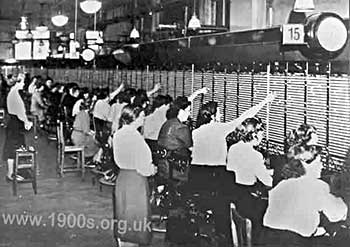
Inside the central telegraph office
Although the service was rapidly declining while I was at the CTO in the mid-1970s, we still handled around 2000 telegrams per day. On Fridays there were even more - around 2500. On Saturday mornings we were inundated with wedding telegrams. Then the traffic died off for the rest of the weekend, although we operated a 24 hour service 7 days per week.
How local post offices handled incoming telegrams for delivery
In the smaller destination post offices, the telegram messages was usually received as the spoken word, dictated over a regular telephone. Then the telegram form was accordingly hand-written by whoever answered the phone.
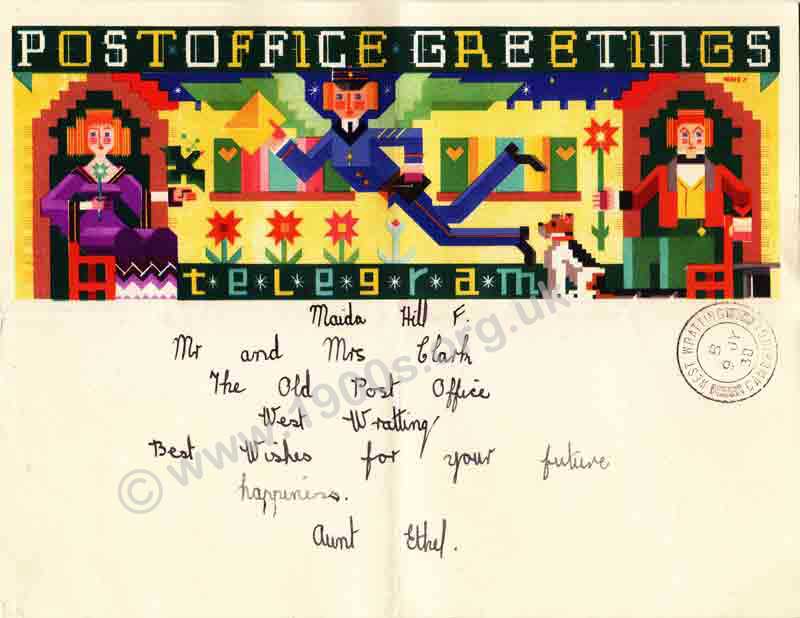
A greetings telegram handwritten at the destination post office. The sender, 'Aunt Ethel' had no input whatsoever to the poor handwriting and shortage of ink.
Note from the webmaster
As the above telegram was dated as early as 1938, it may seem surprising that the Edgware post office had a teleprinter. The reason was that it was large and modern by the standards of the day as it was built to service the rapid expansion of suburbia in the 1930s. I remember it well from my childhood in the 1940s when it was much larger and more airy than the local shops.
By the 1960s and early 70s, most post offices received telegrams on gummed tape via a teleprinter. The gummed tape was approximately half an inch wide and came on a round coil which was fitted to the side of the teleprinter. The telegraphist receiving the telegram would wear what was called a 'thimble cutter', which was similar to a ring with a flat piece of steel on the bottom. This would enable the him or her to activate the gum by running the tape over a small container of water with a brass wheel at the top and then cut the tape. The gummed tape was then stuck onto the telegram form as shown below.
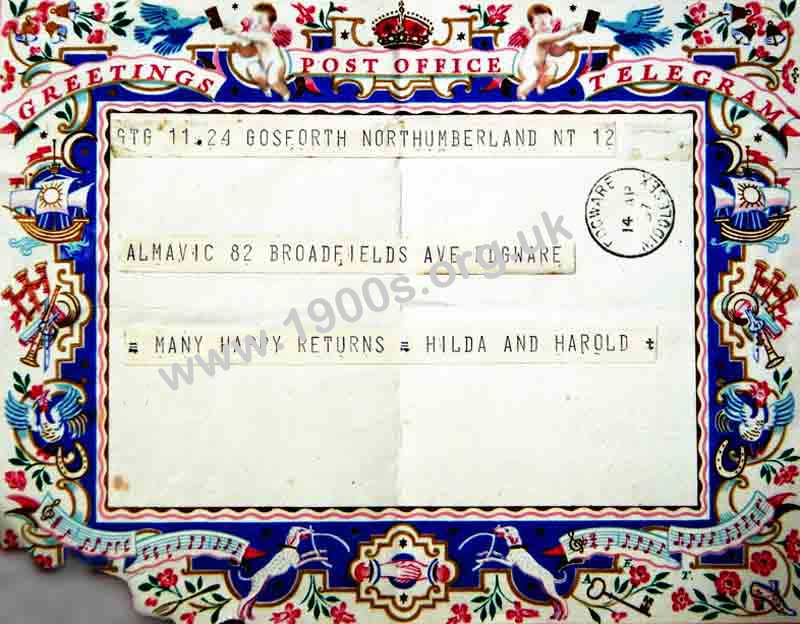
A greetings telegram with the message printed on a teleprinter
Finally the telegram would be folded, put into an envelope and handed to a telegraph boy for delivery. There is more on the experience of telegraph boys on another page.
The telegram form
The top line of a telegram was known as the 'preamble'. It would show the letter and number of the forwarding teleprinter (where relevant), the time the telegram was handed in, the office where it was handed in, the name of the receiving post office or the phone acceptance office, and the number of words. The second line would show the delivery name and address, the third line the message, and at the bottom would be a repeat of any unusual words and figures so that the receiving telegraphist could double check.
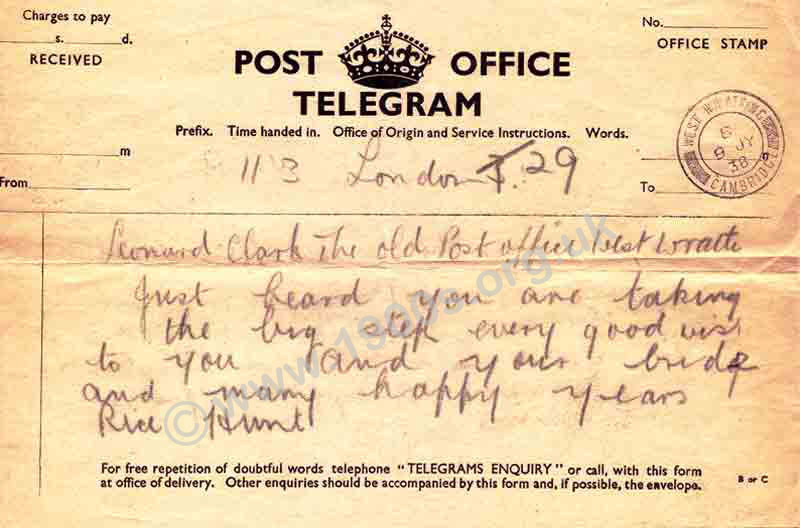
Standard telegram, 1938
Interesting experiences working with telegrams
Telegraphists often talked about the celebrities they 'met' on the phone. Some were regulars and we felt we got to know them on an almost personal basis. Our regulars included Barbara Cartland, Spike Milligan, Anthony Armstrong-Jones and Ned Sherrin, the broadcaster.
I was one of many at the CTO who took Spike Milligan's infamous telegrams. He had many dark moments when he would go into hiding for weeks on end at the top of his house in Bayswater. These self-imposed lockdowns were probably an essential part of his creative genius. During such times, rather than talk to his wife, he would send her telegrams to ask for cups of tea or food. So, he would dial the 190 telephone number and get telegram instructions delivered to his own house! Bizarre but it kept us all amused and in employment!
We had a private teleprinter links to Buckingham Palace, Windsor Castle, Sandringham and Balmoral although the latter two were rarely used. On the Bank Holiday Monday that Lord Mountbatten was murdered, every single phone position at the CTO lit up with callers from all over London and the South East sending telegrams of condolence to the Queen. I was eventually dispatched to Buckingham Palace to help with the load of messages coming in from all over the world.
On first nights at West End theatres, the thespians would send greetings telegrams to one another. The hoary old chestnut message was, "A warm hand on your opening" which usually made up over 70% of all the opening night telegrams. For the life of me, I will never understand why the senders of such telegrams always used to laugh as they recited their message to us, as they had probably sent the same message dozens of times before, over the years, but as politeness and civility was something that we were strictly taught to observe, most of us used to join in with a laugh, even though it was, to all intents and purposes, fake.
The end of telegrams
Record numbers of telegrams were sent during the Second World War, sometimes over a million a day, but afterwards the service began to decline. This gathered speed in the 1960s and 70s due to people becoming better off and having telephones installed in their homes.
In the late 1970s, British Telecomm (BT) took over the service from the Post Office, but it made increasing losses. In early 1981, the decision was made to close the inland service, which finally closed at midnight on Friday 30th September, 1982.
The facility to send telegrams overseas continued for around another 15 years or so.
| sources | webmaster | contact |
Text and images are copyright
If you can add anything to this page or provide a photo, please contact me.



